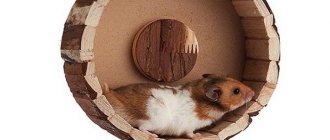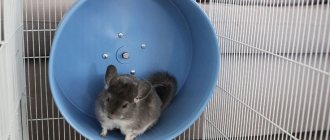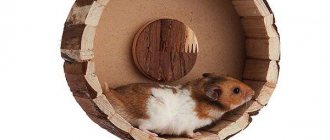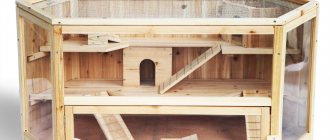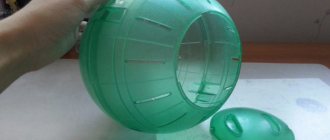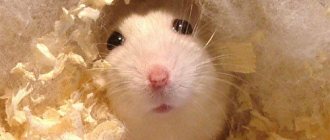Types of wheels
The first parameter when choosing a running wheel for rodents is its diameter, which depends on the size of the pet. Let's look at which running attributes are best suited for the most common types of domestic hamsters - Syrian and Djungarian.
The average length of a Syrian hamster is 12-18 cm; a running wheel with a diameter of 18-22 cm is suitable for it. The dimensions of a Djungarian hamster are about 10 cm - therefore, a wheel for a Djungarian hamster should be at least 10 cm in diameter.
For dwarf species or babies, small diameter wheels are suitable. As your pet grows, the size of this accessory will have to be increased.
The next choice is fastenings. A running wheel for hamsters can be mounted on rods or mounted on a special stand. It is preferable to use the first option, as it is more reliable and secure. When using a wheel stand, there is a possibility of your pet getting various injuries if the distance between the parts is not maintained at least 1 centimeter.
The wheel treadmill itself must meet safety requirements: be non-slippery, made of cast material or in the form of a fine mesh, so that the hamster’s paws do not slip and are not injured. You can protect the work surface with cardboard if it is lattice. However, such a tape will have to be changed periodically, because the hamster likes to use cardboard for household needs.
What should a good running wheel look like?
The requirements for selecting a place for an animal are to comply with the following recommendations:
Hamsters are afraid of drafts. They do not like places that are too hot or cold. Dampness. It is not recommended to place the cage on the floor or windowsill. It is important to place the cage in a smoke-free room.
The bottom of the cage must be covered with dry wood sawdust. The hamster should be kept active by placing it in a cage:
- Climbing ropes.
- Swedish wall.
- Running wheel.
- Labyrinths.
These devices will help your pet meet its motor needs, which will help prolong its life and improve its health.
How to train a hamster to a wheel
As a rule, hamsters are very curious and when the wheel is installed, they immediately begin to sniff it and climb inside.
But it happens that the hamster is not interested in new entertainment. Why doesn't a hamster run in a wheel?
Several factors may contribute to this:
- incorrectly selected wheel size (small wheel),
- unstable fastening, as a result of which the wheel makes loud, sharp sounds when moving (a silent wheel will not frighten the rodent),
- there are distracting objects in the cage (the hamster is more interested in a ladder or a ball),
- the wheel hangs too high (it is difficult for the hamster to climb, and he quickly loses interest).
If you have found out the reason why the hamster does not run in the wheel, then, after eliminating the problem, you can again try to attract the pet to a new toy by putting a treat there.
In order for a new entertainment for a pet to bring benefit and joy, simple conditions must be met: the wheel size is correctly selected, with good fastenings on the bars of the cage and a comfortable treadmill with a notch.
We hope you can now choose the right wheel for your favorite hamster.
Did you like the article? Share with friends: [supsystic-social-sharing id=”1"]
- Related Posts
- Hamster drinking bowl
- How do hamsters see?
- What does a hamster need?
« Previous entry
Upgraded wheels
After using the wheel for a short time, many owners complain about extraneous squeaks or noises that the running wheels begin to create. If a metal wheel squeaks, you can lubricate it with vegetable oil, and the extraneous sounds will recede. In addition, the running wheel can be improved to make it as silent and useful as possible.
Some owners come up with a hamster wheel with a generator, so that the rodent spends its running time with benefit not only for itself, but also for its owner’s environment. Often these things are made by hand, since they do not require a lot of effort and technical steps, allowing you to get electricity for small purposes like charging a mobile phone, which an active rodent can handle.
Another way to reduce noise from a running wheel is to replace the plastic mount with a bearing. Then the wheel will work silently, and will also delight the owners with an additional bonus, since such an invention can be used as a generator.
Step-by-step instructions: how to make an attraction
From a hard drive and a jar
This accessory is quite durable and will serve the animal for a long time. To make it, you will need a tin can of suitable diameter and a screwdriver, a tool for cutting metal and an unnecessary hard drive, hot melt glue and wire.
Remove the cover from the drive by first unscrewing the screws. Then comes the turn of fasteners that secure the mirror plates. Now the engine is accessible, we remove it from the hard drive. Be sure to also remove the extra screws that secure the spindle to the frame.
Now it's the turn of the tin can. Make sure that its walls are not too thin, otherwise the animal will bend them and the wheel will not fulfill its purpose.
It is important to cut off excess material evenly and accurately from a solid container. After cutting, sharp edges will appear on the workpiece, which must be sanded, otherwise the rodent risks injuring themselves on them.
At the next stage, we measure the bottom of the jar and find the center. Then glue the spindle to the marked place
It is important that the engine is placed exactly in the middle. You will also need a porous and soft material, which should be used to equip the inside of the ring
This, of course, is not necessary, but it will make the fluffy more comfortable. Using wire, we attach the exercise machine to the bars of the cage.
From cardboard
The attraction will not be as durable as the previous version, but with precise and careful work it will last a long time. You will need a ruler, a stationery knife, cardboard, a metal sleeve (preferably thin), scissors.
It is better to choose thick cardboard. From it we cut out 2 circles equal in diameter. We cut out wide holes on the parts that will serve as the “entrance” to the simulator. From the remaining material we cut out the base, path and wall, which will act as fasteners. We equip the track with protrusions on both sides so that they fit the holes on the circles.
We connect the running strip with round blanks. We attach a wall to the base, in which we make a hole equal to the diameter of the sleeve. We attach a metal part. We place the cardboard wheel on the hub. Do not forget to equip the structure with jumpers so that the toy does not slip off.
Made of wood
To make such a wheel, we find strong wooden beams (possibly from under a popsicle), wire, and a wooden beam that will act as an axis. We use a metal thread to make two large circles of equal diameter.
You will also need to build 2 smaller circles, they are necessary for attaching the axle. We place small circles inside the large ones and connect them with jumpers. We attach wooden beams to the surface of the upper circles and secure them with wire. We insert the rod inside and fasten the wheel to a suitable place.
Making a toy with your own hands
You can make an attraction for the fluffy miracle yourself. The idea will especially appeal to middle school-age boys who already know how to work with some tools and materials. Involve your kids in creating an exclusive simulator for a cute animal - they will really like the process itself and your trust.
There are several options for creating a simulator. They use different materials, and the level of complexity also differs. We will tell you how to make a hamster wheel with your own hands in different ways.
Toy made from a hard drive and a jar
Thrifty owners rarely throw away broken hard drives. After all, they can be used in some way, for example, to build an attraction for your favorite furry.
You will need:
- damaged hard drive;
- wide metal can;
- insulating tape;
- upholstery material;
- Super glue;
- wire.
In the process of creating a toy, you will need the following tools: scissors for cutting metal, a screwdriver, writing utensils for applying markings.
The instructions will tell you how to make a hamster simulator:
- Unscrew the screws on the faulty hard drive and remove the cover.
- Disconnect the spindle (metal cylinder).
- Use a marker to mark the jar so that the height of the edge from the bottom is 5 cm (for dwarf hamsters) or 7 cm (for Syrian hamsters).
- Using metal scissors, cut the can along the marked outline.
- Now glue the spindle to the bottom and wait for it to dry.
- Cut a piece of fabric to cover the running surface. Polystyrene foam is perfect for this purpose, as it will make the wheel silent (the claws will not scratch the metal). Make the width 1 cm larger than the height of the jar! This will help disguise sharp cuts.
- Glue the fabric, fold the edges outward and secure them with insulating tape.
A comfortable and silent wheel is ready! Attach it to the cage with wire and invite your hamster to his first training session!
If you don’t have an unnecessary hard drive, we suggest you make a hamster wheel with a bearing from a CD drive. The assembly principle is exactly the same as in the case of a hard drive.
Cardboard wheel
Even a schoolchild can make a wheel out of cardboard for his animal. But in order for the piece of furniture to turn out durable and beautiful, everything must be done carefully and accurately.
You will need:
- thin metal sleeve;
- cardboard;
- ruler;
- scissors;
- stationery knife.
First, cut out 2 identical circles of the desired diameter from thick cardboard. Make wide slits on one of them, through which you will later put the hamster in the wheel. Stepping back 0.5 cm from the edges, cut narrow rectangles along the entire circumference with a penknife. Then cut out the base and the wall to which the wheel will be attached. And finally, make a path. When cutting it out, remember that it should have protrusions on each side, equivalent to rectangular holes on the circles.
Now let's start assembling:
- We fix the track between two circles so that its protrusions fit into the rectangular holes.
- Then we attach the base to the wall.
- Make a hole in the wall and insert a metal sleeve into it.
- Place the running wheel on the hub and place jumpers on both sides to prevent it from slipping off.
The attraction is ready! The downside of a cardboard trainer is that the homa will chew it. A plus is the low cost, availability of materials and ease of manufacture.
Wooden attraction
If you have the makings of a carpenter, perseverance and a couple of hours of free time, then try making a wooden attraction for your furry pet. A running circle made of wood will last your pet much longer than a cardboard one. The principle of its creation is the same. The front wall can be made either open or closed.
Many people don’t know how to weave a wheel for their furry. This can be done using small wooden planks, willow wicker or wire. Other materials are also suitable, the main thing is to ensure that the distance between the track slats is not too large.
Cage installation
These animals are social animals, and when they have at least one more degu in their houses, they are simply happy. Your pets love to communicate, so don't leave them unattended. By the way, they can often start chatting excitedly or even grumbling nervously, and this cannot but touch you. The average lifespan of these animals is 5-10 years. Before you get these cute furry animals, consider the following.
The degu will constantly need nutritious food, fresh fresh water and a clean habitat. Degus need daily exercise and play
All members of your family should understand how to keep a pet. Degus are social animals, so you need to constantly communicate with them and pay attention to them. Of all rodent species, degus require more free space.
Making a wheel from an aluminum pan
Making a treadmill from a saucepan is much easier than making it from a sheet of plywood. To do this, you only need an unnecessary or slightly damaged kitchen product of a suitable size. Since the height of the pan is quite large for the animal, which can lead to injury, you need to saw off the edges of the product by approximately 13–16 centimeters.
The edges of the pan must be thoroughly sanded to make them smooth and remove sharp burrs. After this, the wheel must be attached to the tensioner pulley.
How to choose or make your own toys for chinchillas?
If a pet chinchilla has nothing to do, it begins to tear its fur. This is a sad sight not only for pet owners; this condition is dangerous for the animal itself.
Let's figure out how to play with a chinchilla at home and tell you what toys will amuse your little pet.
Main types of toys
Toys for chinchillas presented in online stores are divided into 2 large groups:
- static, allowing you not only to entertain your pet, but also to decorate the interior;
- moving, designed for active games not only inside the cage, but also outside it.
Let's take a closer look at them.
Tunnel
Chinchillas love to hide in wooden and plastic pipes. Choose a transparent product to easily find a pet that has fallen asleep after wasting energy
Pay attention to the size. If the diameter of the tunnel is less than 30 cm, then the animal may get stuck
When choosing wood, pay attention to the edges. The rodent will quickly wear them down if they are not made of metal
Hammock
Manufacturers offer rag, plastic and wooden versions of hammocks with 1 or 2 tiers. In the case of several levels, the pet will receive an additional place to hide.
Shelf
Powerful hind legs need activity, so placing 1 or more shelves will provide excellent exercise. When installing, keep the height not exceeding 80 cm. Otherwise, the animal may be injured if it jumps unsuccessfully.
Ladder
Miniature ladders develop paws and are suitable for back scratching and sharpening teeth. An ordinary wooden stick placed vertically can be a budget option. Chinchillas love to jump and the ladder is an excellent exercise machine for them.
Walking ball
A plastic product allows you to walk around the room, but poor ventilation significantly reduces the walking time. Frequent cases of overheating of animals is a serious disadvantage of this interesting little thing.
For the safety of the chinchilla, you need to keep track of time, so instead of buying such a dubious toy, remove unnecessary objects from the room and let the animal run around on its own.
DIY toys for chinchillas
Some manufacturers, trying to reduce costs, skimp on quality. As a result, the final product not only loses quality, but also becomes dangerous.
Products to avoid:
- from cheap plastic, lime, glass, rubber, cement, cardboard and paper;
- containing small parts (during play the rodent may choke on them);
- bright colors (all factory paint will transfer to the animal’s fur);
- with sharp corners and rough surface;
- with a strong odor, indicating an excessive amount of dangerous chemicals;
- from pine needles, oak and cherry containing resin (poisoning).
The best solution to the problem is to make toys for the chinchilla with your own hands. A handmade item will not only protect your pet from an unscrupulous manufacturer, but will also help you save money.
Why do you need a running wheel for chinchillas?
Pet breeders often wonder how necessary a wheel is. This attribute is required to prevent the chinchilla's muscle atrophy from occurring. Regular use of the wheel by a pet whose mobility is limited within the cage is important. Plus, running on a wheel is a fun activity for your pet.
Which material to choose?
There are several different materials you can use for a wheel. One of them is plastic. Moisture is not absorbed by this material, which avoids the appearance of an unpleasant odor.
Another material is metal, but its use for a wheel should be done with extreme caution, since the material is traumatic for chinchillas, which must be kept in mind. You can reduce the risk of injury by using the most ordinary fabric. It needs to be wrapped around the surface of the wheel.
One of the best materials can be called wood. The only disadvantages include a high level of absorption of both moisture and odors. It is almost impossible to wash a contaminated wheel surface, and it will be even more difficult to get rid of the unpleasant odor. In this case, pet owners simply periodically replace the old wooden wheel with a new one as it gets dirty.
Hard drive toy
Before you develop your own chinchilla wheel from the mentioned item, you need to prepare the following materials and tools:
- wide and light tin container;
- upholstery material (for example, cotton fabric or cork mat);
- electrical tape;
- hot glue;
- wire or nylon ties;
- screwdriver;
- scissors for cutting metal;
- marker.
If there is no damaged or old hard drive, this part can be replaced with the motor from the drive.
Wooden wheels
Wooden wheels are quite expensive and therefore are usually made only to order. They are often placed in display cages.
Despite the fact that such products have a lot of advantages, they also have negative features:
- animals love to chew wood, so such a simulator can very quickly become unusable;
- Rodents can make a toilet in such a wheel, which will also lead to its damage.
